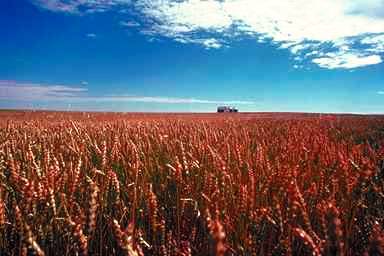Saskatchewan -

Saskatchewan is one of Canada's 10 provinces, located in the Prairies. Its southern third is predominantly prairie (with a reputation for being very flat), and the province is known for its economically important agricultural outputs, such as wheat and canola.
Despite Saskatchewan's reputation for its prairie geography, there is a surprising variety of landscapes, including the hills and lakes in the north, a lake with water that is denser than the Dead Sea, and the North and South Saskatchewan rivers.
Saskatchewan also features historical sites related to the North-West Rebellion. In 1885, Louis Riel, leader of the Métis (persons of mixed French Canadian and Aboriginal descent), led an uprising against the Canadian government that culminated in the Battle of Batoche. The interpretive centre at Batoche remains a popular tourist destination. While the battles were not particularly large by world standards, the Rebellion was politically significant for the Canadian west, and offers a glimpse into what life was like on the Canadian frontier.
The fresh air and open sky are other distinctive features of the prairie. There is little light pollution, and therefore stargazing would be wonderful, if not for the mosquitoes in the summer and the cold temperatures and winds in the winter.
Saskatchewan's population used to be primarily rural, but is becoming more urban. The population has been declining for many years, since young people have been leaving to pursue better opportunities in other provinces. Farming remains the largest sector of the economy, though it is becoming economically unviable. There are some attempts to grow other sectors of the economy, such as scientific research and technology. For example, a synchrotron is being built at the University of Saskatchewan in Saskatoon.
Saskatchewan, unlike the rest of Canada, does not participate in Daylight Savings Time. This means that in the winter, it is in the same time zone as Manitoba, and in the summer it is in the same time zone as Alberta.
• Oilfield industry is very extensive in the south eastern section of the province. Possibly second to Alberta in production (?), but that is pending the offshore fields in the Maritimes coming online. (Jan 2006)
• Mining: Potash (Kindersley?). Lignite coal (Estevan). Uranium deposits in extreme north.
Get in
Most visitors to Saskatchewan arrive either by automobile or via one of its two major airports, the John G. Diefenbaker International Airport in Saskatoon and the Regina International Airport.
The Trans-Canada Highway (Highway #1) runs across the southern portion of the province (including Regina and Moose Jaw), connecting Saskatchewan to Alberta and Manitoba. Similarly, the Yellowhead Highway (Highway #16) bisects the central part of the province, running through Saskatoon and North Battleford. There are a number of US-Canada border crossings in the south, on the highways running between the two countries.
Stay safe
Saskatchewan has a reputation for being a very safe place to visit. Its people are generally very friendly, and although it is not known as one of Canada's more cosmopolitan regions, residents are at least tolerant of different cultures and lifestyles. Some parts of the larger cities, such as Saskatoon, Regina, and Prince Albert, have seedier areas that should be avoided at night, but realistically, most travelers will have no reason to be in "the bad part of town" at night anyway.
Winters can be extremely cold, and when combined with heavy snowfall and wind, blizzards can make driving dangerous. Many of Saskatchewan's highways have been poorly maintained, and when combined with icy pavement or heavy traffic, they can be dangerous for inexperienced or inattentive drivers. Many rural roads are unpaved, so drivers unfamiliar with gravel roads should take their time.
Adapted from WikiTravel under the Wiki License
Home | Add/Modify Listing | Photo Gallery | Maps | Contact | About Us | USA Privacy Statement
This site is operated by 2025 Cedar Lake Software
LastModified: Apr-12-10
